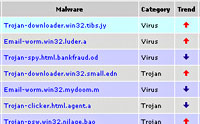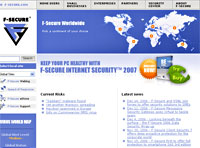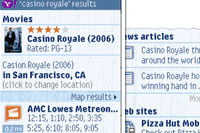In just six months, image spam has become so prevalent that it now represents a hefty 35 per cent of all junk email, according to internet security firm F-Secure.
 In ye olde days, spammers just used to send out bucket loads of text-based emails, but these were proving progressively less effective against smarter anti-spam software employing tricks such as dictionary-based content filters.
In ye olde days, spammers just used to send out bucket loads of text-based emails, but these were proving progressively less effective against smarter anti-spam software employing tricks such as dictionary-based content filters.
In an attempt to bypass content filters, spammers have taken to sending text displayed in a GIF image, coupled with random text content nicked from legitimate web sites.
 All spam is annoying, but with its bundled images, this new technique adds a double whammy of gobbling up more precious bandwidth to deliver its spam-tastic cargo.
All spam is annoying, but with its bundled images, this new technique adds a double whammy of gobbling up more precious bandwidth to deliver its spam-tastic cargo.
According to F-Secure, spam makes up 90 per cent of all emails worldwide, with image spam hogging 70 per cent of the bandwidth.
“Image spam is a serious and growing problem. It also is taking up 70 per cent of the bandwidth bulge, on account of the large file sizes every single one represents,’” commented Mikko Hypponen, chief research officer at F-Secure.
 Sadly, the root of the problem with spam is the chumps who keep on responding and buying the dubious wares on offer (a bit like the mad fools who come down to Brixton to buy ‘drugs’).
Sadly, the root of the problem with spam is the chumps who keep on responding and buying the dubious wares on offer (a bit like the mad fools who come down to Brixton to buy ‘drugs’).
“We will never rid ourselves of spam until people stop buying the products advertised in these mails. Spam obviously works, otherwise it would not be so prevalent,” said Hypponen.
Say it like it is, Mr Hypponen!
Comments
4 responses to “Image Spam Creates Growing Problem”
Spam irritates me greatly. It could be stopped very quickly if, as with text messages on a mobile, there was a cost to send the email. I would happily pay 5 pence per transmission, with multiple recipients multiplying the cost. It would still be a cheap and convenient means of communication but would not be worthwhile for spammers. Perhaps we could receive 1p of that for each email we receive, leaving the service provider with 4p to cover the admin costs……. Then, at least there would be benefit in receiving spam.
At present, I am clearing out some 200-300 spam emails per day leaving the 10-20 business emails difficult to find, especially as about half of the legitimate mails are identified as spam by my filter…..
I wonder what the spammer think about getting spam?
Are they as irritated by it as everyone else in the world is, or do they get excited when they get it, wondering where it originates?
Damn that spam!
The problem(s) with charging a fee for emails is 1) who gets the money and 2) will there be checks and balances for that system?
Here in the United States cost of postage (basic letters) has gone up and up. Only 10 years ago postage was 10 cents but now is more than 30 cents. So let’s say that there is some cost for emails. Who will collect it? And try to keep governments from dipping their hands into it (and you know they will because they believe they are entitled to money they didn’t earn).
Even if your ISP will collect the cost there will soon be package deals just like your cell phones with so many emails for 10 dollars a month or unlimited emails for 50 dollars. So there really is no way around this unless there are stiffer penalties for the crimes and people who spend more time and energy into catching the spammers.
The reaction to Yahoo and AOL when they suggested somthing similar wasn’t … how shall I put it … very warm. But it was brave of them to suggest it.
Personally, email has become an evil necessity, one I only resort to if I don’t have IM contact with.
It might only become viable again if the trust network that comes with social networks lets you check against the validity of the sender.